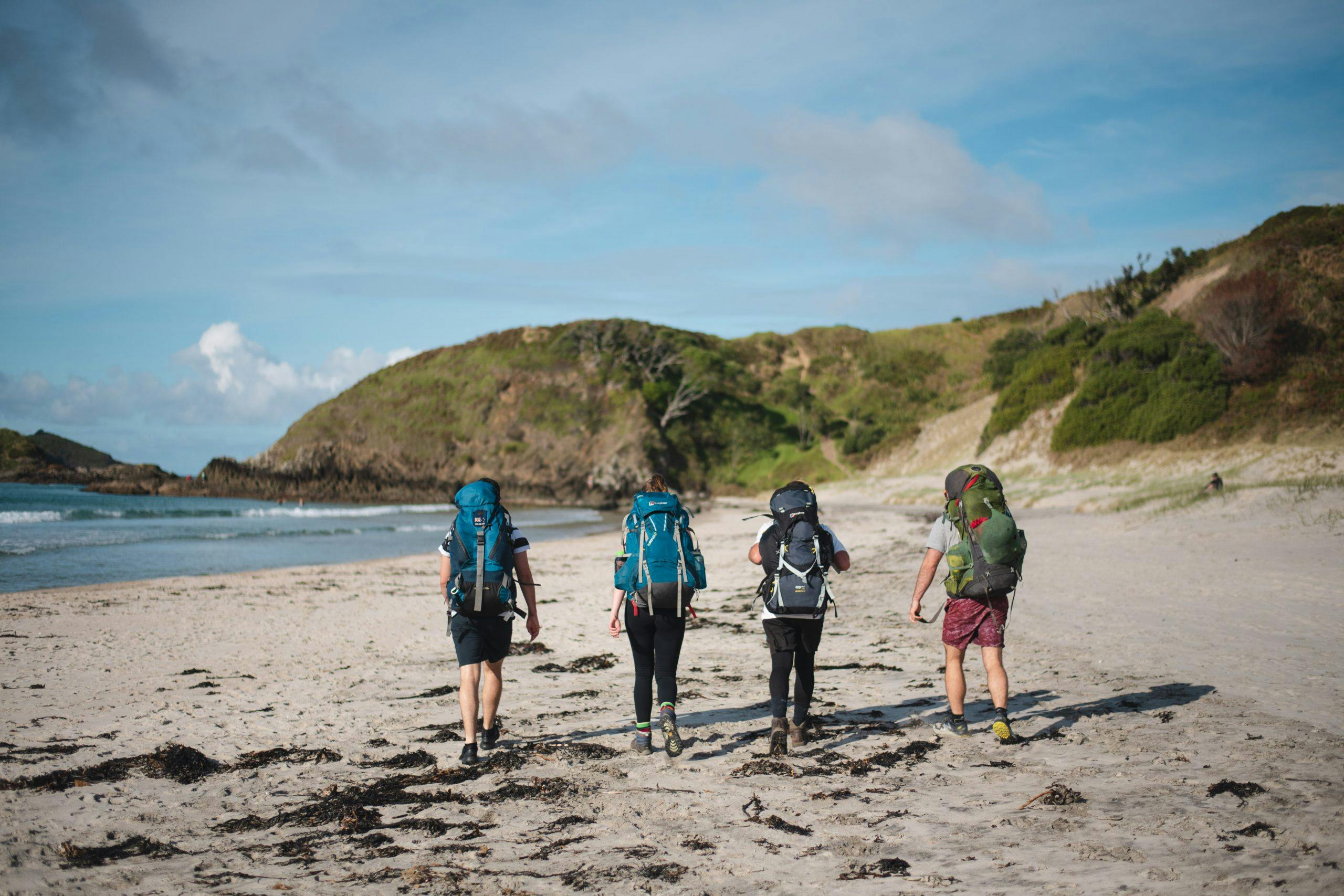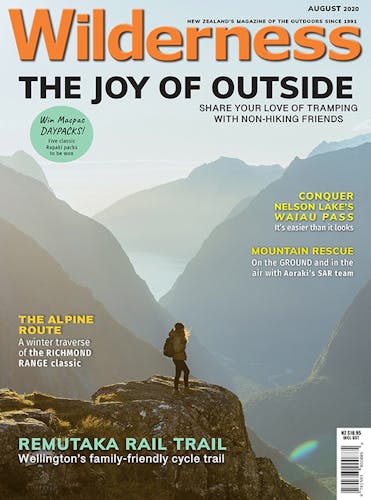Determined to spread the love of tramping, Matthew Cattin starts a club to get inexperienced friends outdoors
When the sting of a long drop hits your nostrils or hut snorers rob your sleep, tramping can seem more punishment than privilege.
And who has the composure to practise gratitude when both feet call it a day after eight hours of neglect? Or a weka steals your dehy dinner?
Tramping can be a hard sell on paper; it’s exhausting, painful, and in many cases miserable, and perhaps that’s why it’s easy to forget how bloody lucky we are to do it.
Whether by good fortune or tenacity, we trampers have gathered the gear and skills to safely experience the wilderness in ways others can’t.
And last year this dawned on me. Looking back, I aligned the many enabling factors of my upbringing which made me a confident tramper today. I was lucky to attend a school with an established Duke of Edinburgh scheme, and luckier still to have parents who not only took me tramping but funded my first trips and gear – as well as loaning spare kit to other kids. I was equally fortunate to find friends who shared my outdoor obsession and loved getting outside during the weekend.
I realised how many barriers exist to obstruct non-trampers trying to get into the outdoors, whether it be lack of skills, gear, confidence, or simply having nobody to go with.
I put word out to my Facebook circle: was there anybody out there who would like to tramp, but didn’t know where to start? The comments flooded in.
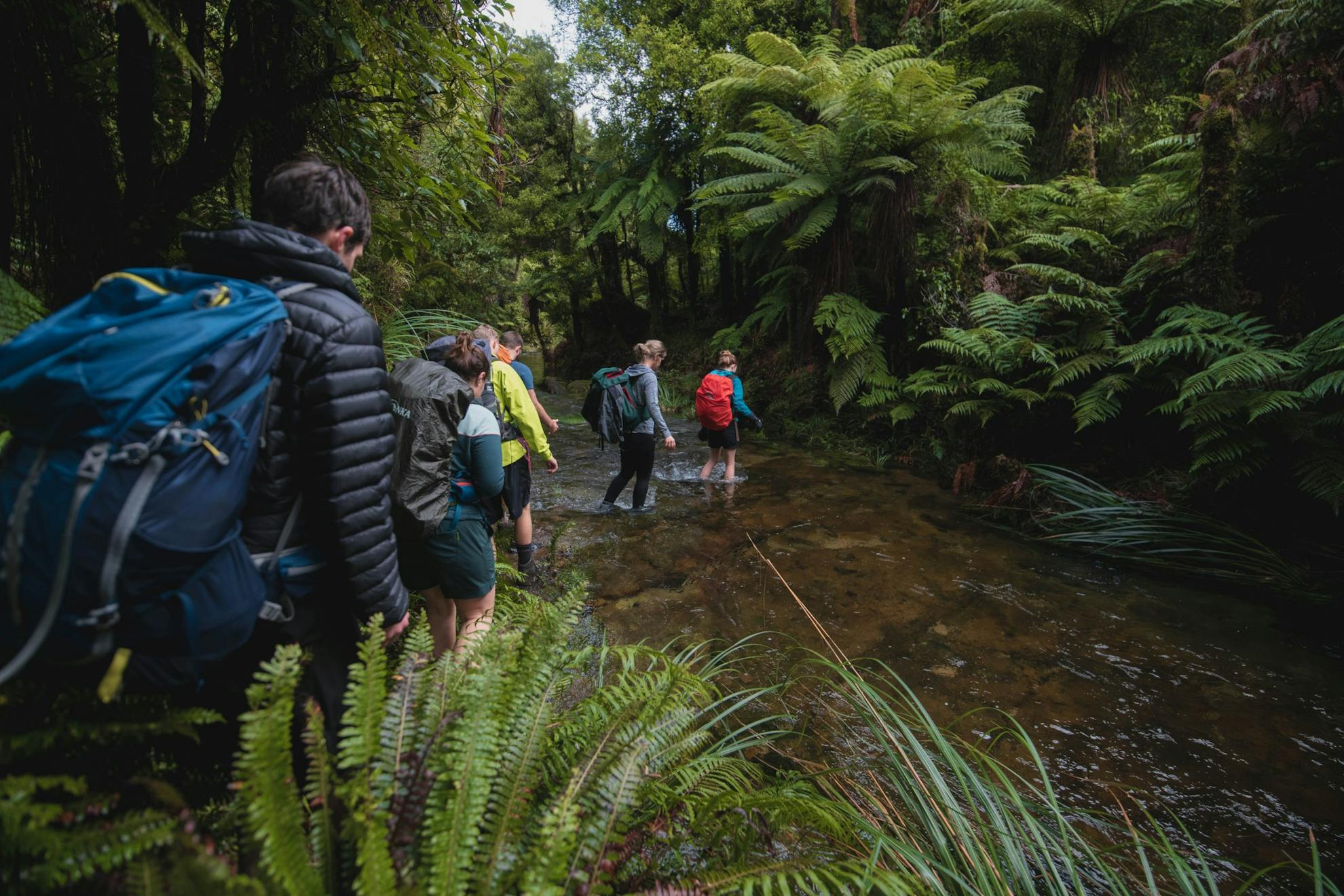
A tramping club is born
By the end of the week, more than 50 people – including strangers – had expressed interest in joining the ‘Tramping Troop’, and I invited all to join a private Facebook group.
I then booked out two huts for weekend excursions, and posted the details onto the page – within a few hours, every bunk was snapped up.
With bookings made, anxiety sank in. Did I have the expertise and charisma to take people tramping, and not put them off for life? What if somebody had an allergic reaction to bush tea? And what if group members showed up in jeans and casual footwear? Before I had a chance to find out, the country went into lockdown, and both trips were cancelled.
When the country shifted to level 2, I rekindled my energy and re-booked the same trips just a couple of months later. Once again, both trips reached capacity.
I got started with trip planning, reaching out to everyone individually and in groups to ensure we were all on the same page with confidence, gear and preparation.
I also wrote a buyer’s guide detailing the importance of good gear, covering the basics trampers take for granted; that water-resistant does not mean waterproof, that cotton is not to be tramped in, and that loft ratings have nothing to do with ceiling storage. Other trampers added their own useful tips.
Finally, after the changing of three seasons, months of fretting and a global pandemic, it was time to put boots to soil and set out on the Tramping Troop’s first trip.
Beginner tip: How do I buy a hut ticket?
For huts that aren’t on the booking system, trampers will need to purchase a backcountry hut pass or hut tickets. A backcountry hut pass costs adults $122 for 12 months or $92 for six months, and will be accepted in most serviced and standard huts, whereas hut tickets are for single use only, and best suited for occasional trampers.
Hut tickets are colour coordinated with yellow to youth, blue for standard adults, and green for
serviced adults. Youth will need to use three yellow tickets to stay in a serviced hut. Hut tickets can be found at a number of i-Sites, DOC visitor centres, YHA hostels and outdoor retailers nationwide, including Bivouac, Macpac, Hunting & Fishing and Kathmandu. Many independent retailers also stock them, but check in with your local first.
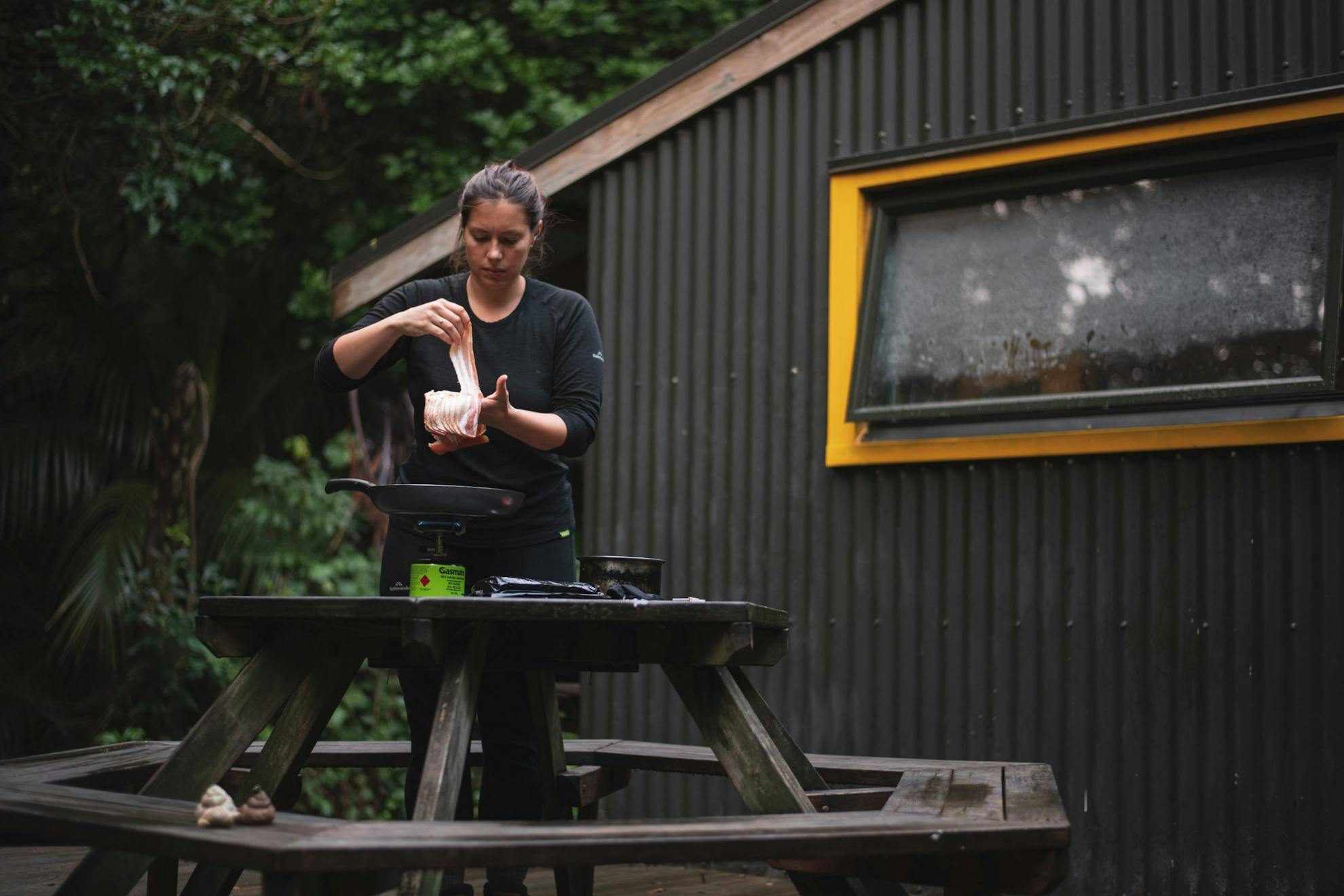
The maiden adventure
Northland’s Te Whara Track, with an overnight stay at the cosy eight-bunk Peach Cove Hut, was an obvious first outing for the group. The perfect mix of views, adventure and challenge, the track isn’t overly long, but your legs will certainly feel its many steps the next day.
Safety is always a huge consideration of my tramping, but so much more so when taking responsibility for lesser experienced group members. I always leave accurate intentions with my family group chat and carry a PLB, but as a trip organiser, is that enough?
Heather Grady from Outdoor Training New Zealand provided invaluable advice. She says intentions should include more than just the route and the time you expect to return.
“Have an emergency contact who will be available, and who will be sensible if you are late back,” she says. “They need to know who is on the trip, and your trip plan, including escape routes and alternate plans.”
Group members should all be briefed on the route and stay together. Groups may like to use a leader who nobody overtakes and a ‘tail-end Charlie’ who nobody goes behind.
“The group should stop at any track junction or decision point and wait for the whole group before moving on,” Grady says.
Good tramping clubs have graded routes and beginners are relegated to easy trips until they have proved they’re capable of achieving a higher grade.
“Choose routes that you are confident will be suitable for all participants. It’s hard when you don’t know the people, so go easy until you do know them,” she says.
Three of my party had never slept in a hut before, but I was confident the track would be suitable for all.
After dropping one car at the Urquharts Bay road end, we assembled at Peach Cove car park to divide food and spare gear between everyone. Feeling somewhat guilty for the outrageous amount of food I’d organised, I shouldered several kilograms more than my fair share – something I’d live to regret on the 476m climb to Te Whara Peak.
Given everybody’s varying levels of experience and access to cooking gear, my partner and I decided the easiest way to organise food was to arrange dinner and breakfast and split the bill. We also had a hunch that gourmet meals would do more to win over trampers than the hundreds of stairs en route to the hut.
Thus, we ended up with an absurd amount of food; an entrée of beer cheese fondue, steak, lime and coriander burritos, steamed pudding, mulled wine, and a cooked breakfast of egg, cheese and bacon croissants – all for just $16 each.
The three-hour trek to Peach Cove Hut was a test for the legs, but it went – mostly – without a hitch. Having climbed a rock pillar to catch views of the setting sun, we were interrupted on the descent by an irate cloud of wasps, which left three of us with stings to hands, arms and heads.
With curse words dropped and antihistamines downed, we moved on.
We arrived at the hut just on dusk. It’s planted in a clearing beside a house-sized boulder which wears a sprawling pohutukawa like a fascinator.
The rain had so far held off, so packs down, we hightailed it to Peach Cove for a bracing swim in our patch of paradise, hollering with cold and the thrill of being utterly alone in nature. Shared trauma bonds people – as does shrivelling mid-winter dips – and to my delight and relief, everybody seemed to be buzzing.
As we retreated to the hut, the clouds relented, spilling light sprinkles over the canopy. Kiwi called outside as we ate dinner and drank mulled wine – a combo which put us quickly into food comas. As we nestled into sleeping bags, rain tinkered onto the roof and gentle snores sounded in the dark.
The hearty breakfast and the sizzle of bacon prepared us for the 800-stair climb to the junction and the quad-quashing descent to Smugglers Bay, where we soothed shaking legs with another icy swim.
Save for the wasps, the trip was a complete success, and eight happy, tired trampers drove home, revelling in the contentment a great weekend brings – all keen for another expedition.
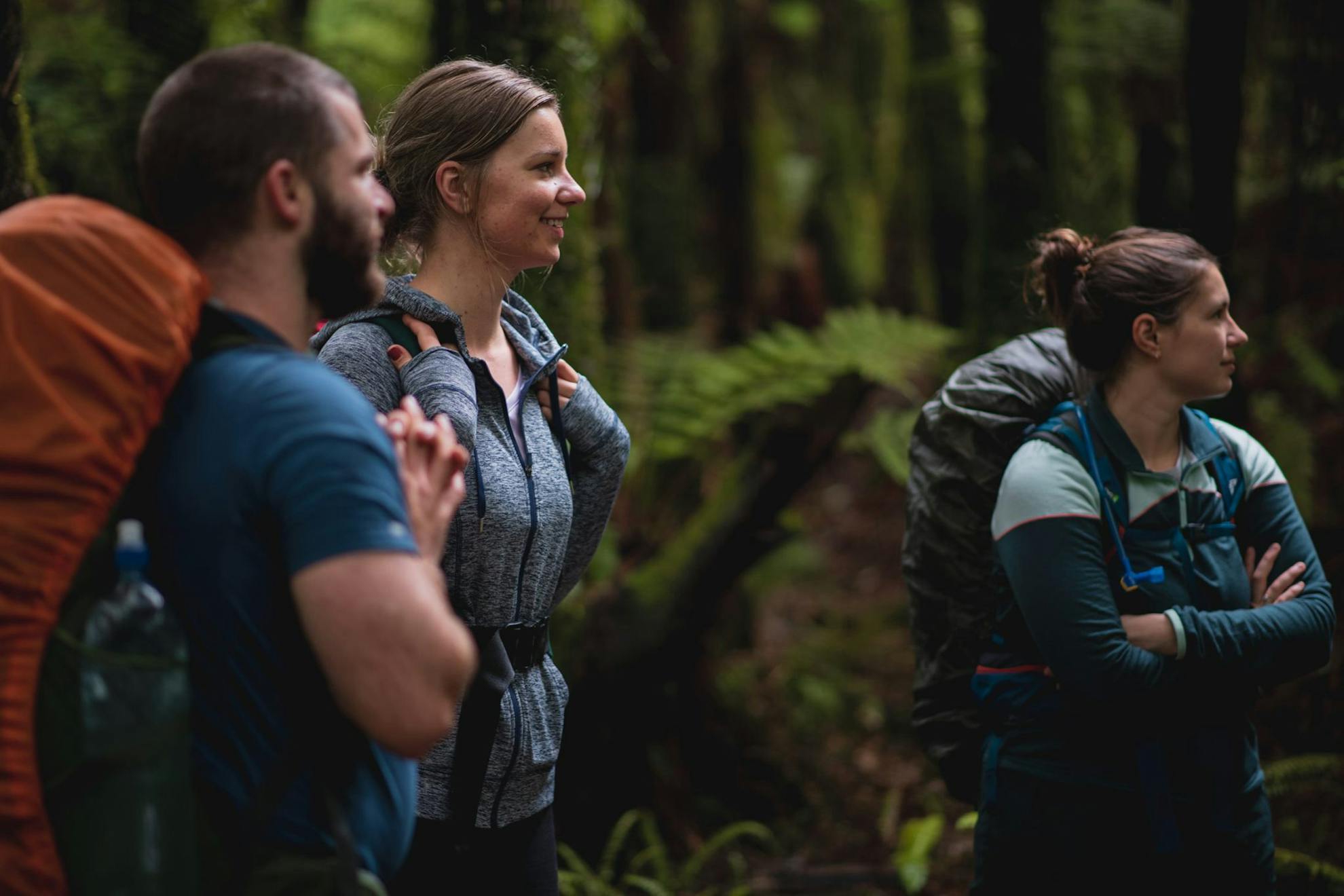
A trying take two
My next planned outing was to Te Whare Okioki, a gorgeous 12-bunk hut built in 2019 in Kaimai Mamaku Conservation Park. Doubtful about the amount of scenery we would find ascending Te Tuhi Track, I planned Sunday’s exit via the North South Track and the stunning Wairere Falls Track, which I’ve walked before. Though it would involve a short car shuffle, tramping without pay-offs is punishment enough to put off beginners.
As the weekend approached, the forecast worsened and my group slowly dropped from a healthy dozen to just seven – the last two cancellations rolling in the night before.
I had warned the group our route involved river crossings and assured them we wouldn’t take any risks. As a plan B, I suggested we scrap the hut and do a day walk to Wairere Falls.
While I was confident nobody would get lost, I did worry high rivers would end our trip before it truly began.
At the Te Tuhi Road car park, we watched squalls trail over the ranges like bridal veils from the safety of our cars. Catching a lucky break with the weather, we made short work of the climb to Manganui Stream in light drizzle, happy to be away from the big smoke in spite of the weather.
Smiles flattened when we squelched to the water’s edge. Feisty and fast, the stream was acting as gatekeeper to the forest, allowing only the determined to enter.
Though not a wide river, it was knee-deep and swift and would have defeated us if not for a safety wire spanning its width. I cautiously crossed to a midway boulder, where I could safely sit and offer an arm to each person crossing. It was the first – and fortunately the gnarliest – of several crossings we would encounter that weekend, and the last time our feet would know the comfort of a dry boot.
Our route then wound its way east, climbing steadily higher as swirling winds whipped the canopy above. After two more river crossings, we turned south onto the suffocating North South Track. Under the claustrophobic canopy and oppressive skies, mid-afternoon transformed into twilight.
We observed how easy it would be to miss the trail in such conditions – a concern that resonated with group member Natasha Wesbonk, 27.
“My biggest fears and anxieties would be around direction,” she says. “I have had an experience of being lost in the bush and it’s not really a feeling you ever forget.”
New to overnight tramping, Wesbonk says it isn’t a hobby that can be decided on a whim, and the planning and research needed to get into it can be “overwhelming”.
Knowing which gear to buy – without breaking the bank – is particularly hindering. From the bottom, looking up, tramping costs are a steep, muddy slog, and it’s easy to sink thousands of dollars just for the bare essentials; a pack, rain jacket, boots and a sleeping bag.
It feels wrong to say tramping is all about the gear, but it’s an inescapable truth – good gear is armour, comfort and safety, and nobody gets far without it. Give a first-time tramper a flimsy rain jacket, lumpy pack and blisters, and you’ll give them a good excuse to never go out again.
With more gear than I need, I’m happy lending it out to keep people comfortable and warm – the alternative is a very unpleasant, unsafe or expensive trip for a new tramper.
“Spending copious amounts of money on something that you’re unsure of or even sure you will use again can be confusing and a bit of a barrier,” Wesbonk says. “It could be the most cost-effective weekend all year, or the most expensive, depending on what you need.”
Knowing what to expect on each tramp is another unknown variable for Wesbonk.
Beginner tip: Where can I hire gear?
If you’re new to tramping and you don’t want to commit thousands of dollars on gear you may never use again, it’s a good idea to try before you buy.
Several retailers – including Bivouac, Pack Gear Go and Living Simply – will loan all the essentials, includings packs, sleeping bags, tents and rain jackets. Items cost as little as $6 a day, but you may need to pay a deposit.
A PLB should always be carried whether tramping solo or in a group, and though expensive to purchase, they can be hired at retailers, i-Sites, DOC visitor centres, and several PLB hire companies from $10 a day. An extensive list of hire outlets can be found on the Mountain Safety Council website – www.mountainsafety.org.nz.
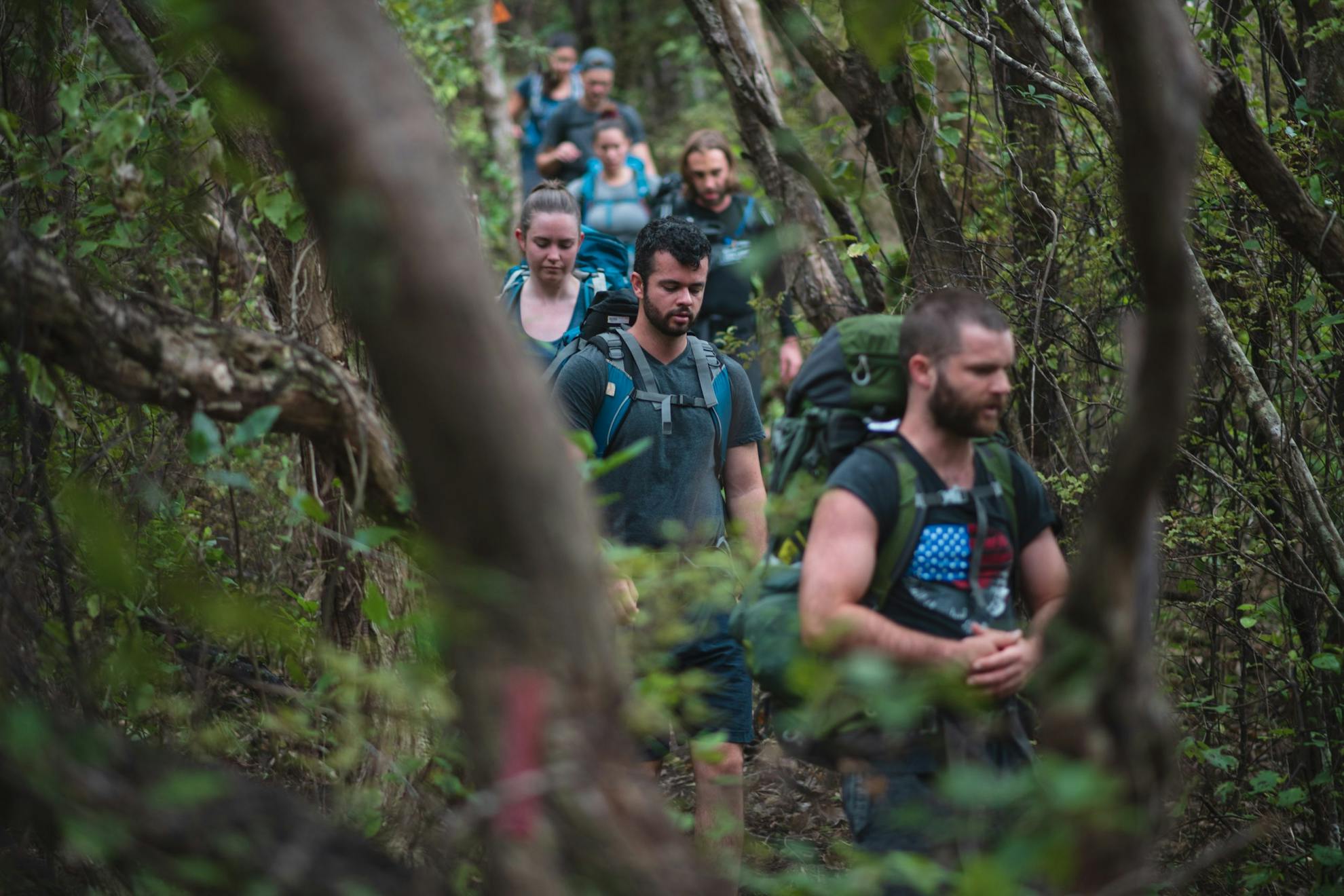
“I would feel comfortable planning a well-known hike such as The Pinnacles – a hike I have done before – but I wouldn’t feel confident planning a trip I haven’t been on before because of the lack of knowledge and a fear of the unexpected,” she says.
“I wouldn’t know much around what hikes there are to do, what hikes are more suitable for beginners or what fitness level they are aimed at.”
On the North South Track, a rogue thunder crack spurred squelching boots, and before long we were thrown out of the gloom into the welcoming clearing of Te Whare Okioki – ‘the resting place’. For the first time in hours we saw the sky, and not two minutes after our arrival, it threw a violent tantrum, pouring fury onto the roof while we hollered in defiance. The weather had won a few battles, but we won the war.
Tramping camaraderie was the aspect that most stood out for Justin Maher, a new tramper.
“What drew me to tramping was not the lure of nature or the absence of technology – it was the wish for adventure and companionship,” he says. “I liken hiking to my travels abroad, jumping from one hostel to another, sharing stories, banter and laughter.”
Maher had no suitable tramping gear of his own and this made him feel trampng was ‘a bridge too far’. He was only able to join us because I loaned him my spare pack, raincoat, insulated jacket and tramping boots.
“Fitness never felt an issue as I live a relatively active and healthy lifestyle, but the thought of river crossings, rain and cold were cause for concern. Though we had adequate gear and a contingency plan to boot, the fear lingered,” he says.
The thought of joining a group of mostly strangers also gave Maher pause.
“I had some social anxiety for sure, but I needn’t have worried – the nature of hiking forces fellowship,” he says. “Watching each other’s step, ready and willing to catch each other’s fall, everyone plays their part in keeping spirits high whether it’s humour, photography, word games, or nature.”
Upon reaching the hut, Maher says he felt everyone had been friends for years.
Boots off. Fire on. Hot drinks. When you truly need them, huts are nothing short of spiritual, and after ravioli pasta and mulled wine, we were lulled into an early sleep.
Morning skies were brighter, and after a breakfast of creamy porridge and stewed rhubarb, we pointed our toes north towards Wairere Falls.
It’s hard to beat forest after rain and the group made easy miles over mostly flat terrain, as everything glistened above. The falls were at the full height of their powers, an exhilarating and rewarding silver lining for our determination.
Where Peach Cove had been familiar and easy, the Kaimai trip was a challenging test – a true adventure – and the group reached the car park with satisfied smiles.
Future trails
Tramping isn’t as simple as lacing up a pair of boots – it’s a combination of confidence, skills, gear and knowledge collected over years of experience.
I’d be willing to wager that for every Kiwi tramper out there, there are two non-trampers just waiting for the opportunity to give it a go and as I continue my tramping career, I feel it would be rude not to seek out those who don’t know their Kaimais from their Kaimanawas.
So, if you’ve got spare gear lying around and a free weekend, why not reach out to your wider social circle? You’ll be surprised how many people out there can’t wait to give it a go.





